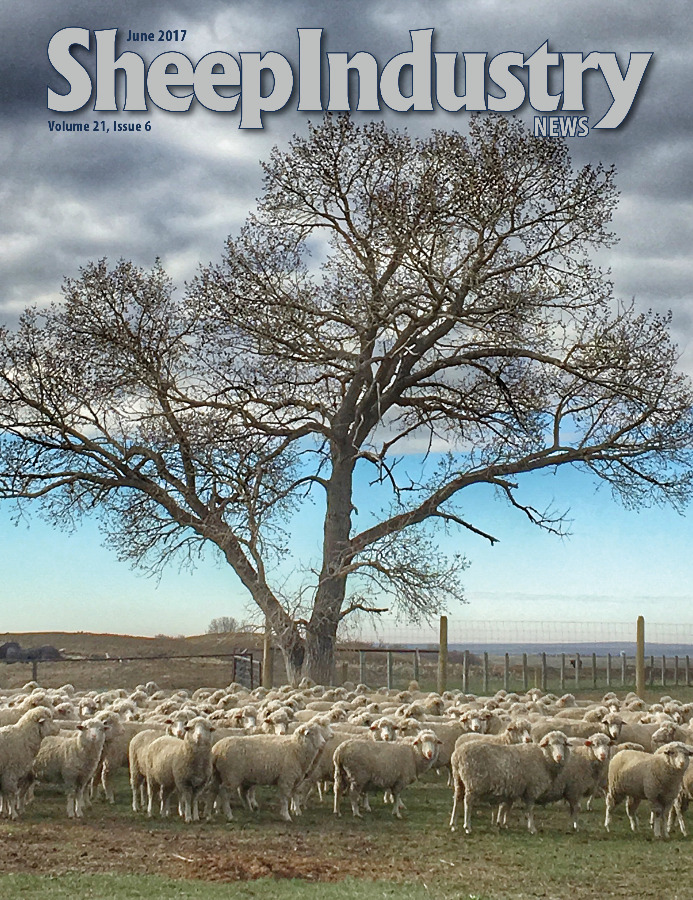
- June 2017
- President’s Notes
- ASI Submits Nominees for ALB, NSIIC
- Industry Sets Research Priorities
- Photo Contest Now Open
- Vermont Natural Lamb
- Opportunities to Expand
- Let’s Grow Supports Education
- Let’s Grow Awards Round Five Grants
- NSIP Certification Launches
- ASI Represents Industry at IWTO
- Market Report
- California Ram Sale a Success
- Nasal Swabs Needed for Research
- The Last Word
Opportunities to Expand
Lamb Trends Higher Among American Consumers
EMILEE GIBB
Wyoming Livestock Roundup
The key to growth for sheep producers is simply convincing the American consumer to give lamb a try.
“Lamb is a trendy protein, and I think it’s something we are able to have value for within our industry,” said Travis Hoffman of North Dakota State University and the University of Minnesota.
On April 25, Hoffman led a discussion for ASI’s Let’s Grow Committee on lamb meat quality and current market trends. Approximately 40 percent of consumers have never eaten lamb, said Hoffman, citing a study by the American Lamb Board.
“I think we can be well aware that many probably have never tried it,” he commented. “If we had more people that tried it, we can be able to hope to have more repeat customers.”
When looking at the demographics of lamb consumers, Hoffman noted that males consume a slightly larger amount of lamb.
He continued, “Those with a greater amount of income are also more prone to consume lamb,” explaining that those consumers expect to spend 30 percent more in sales or retail for lamb products.
In general, U.S. lamb consumers prefer to purchase lamb raised in the United States.
“Not only would they prefer to buy it, over half of them are willing to pay for it,” Hoffman stressed. “There’s certainly a little bit of a price disparity in comparison to our competition, and that’s why we need to focus on our quality attributes.”
“We can certainly identify the weeks or time of the year, which is around Easter, where we can expect a spike in both dollars and pounds sold,” said Hoffman.
According to a survey, Hoffman explained that 38 percent of the households that consume lamb purchase the protein for home preparation each year.
When analyzing consumers who are purchasing lamb, there are two primary groups that increase in size and amount purchased.
“One of those groups is the millennials and those individuals who are able to make a little bit of money now and be adventurous in their purchasing options,” commented Hoffman.
He continued, “Also, we’re seeing an increase with some of those mature perfectionists, as some people have termed, who are people on the back end of their career who just want to do something a little more entertaining in what they’re consuming.”
According to Hoffman, the average price of all lamb cuts in the United States in 2016 was $6.97, and there was an increase in the amount of product sold.
“In 2016, at retail, we had an increase in lamb dollars sold of 1.5 percent and an increase in the pounds of lamb sold of approximately 3.7 percent relative to the number of pounds sold at retail,” he said.
When looking at features recorded by USDA Agricultural Marketing Service, Hoffman noted that the most frequently featured product was bone-in leg at $5.70 per pound.
“That was followed by racks at $10.85 per pound, loin chops at $7.82 and shoulder chops at $4.98,” he commented.
When looking at the percentage of cuts and primals sold, the largest percentage that goes to retail is loins.
He continued, “Loins are followed in popularity by leg, rack, shoulder and ground lamb.”
When looking at the top trends in the restaurant industry, Hoffman highlighted three as being important factors in how to market U.S. lamb.
“In the top six restaurant trends, I want to note natural ingredients and clean menus, environmental sustainability and locally sourced meat and seafood,” he said. “I think those three will all pertain to how lamb can fit into those restaurant trends.”
In the restaurant industry, Hoffman explained that high value cuts still dominate, but others are increasing in popularity.
“Rack of lamb is used most often, followed by the loin chop, as we would expect, but there is still some market share out there for restaurant opportunities for sausages, shank, loin and leg and shoulder,” he commented. “We’re also seeing an increase in lamb burgers.”
“I’d be remiss if I didn’t talk about lamb quality and a little bit on the nontraditional market,” said Hoffman. “Not only is this area continuing to grow, it’s changing the game.”
According to Hoffman, ethnic markets provide opportunities to connect with more consumers, as well as to utilize more varied cuts.
“With our ethnic marketing, we have an opportunity to meet the needs and requests from several different individuals within our American scheme of consumers,” he commented, noting that there is an increased interest in ethnic cuisines.
“When people want a bold flavor or something that’s more entertaining, they can now look through Mediterranean, Spanish, Caribbean, Middle Eastern, French or Thai restaurants,” Hoffman concluded.
View the archived version of the most recent Let’s Grow Committee-funded webinar (as well as the previous 19 webinars) by visiting: Youtube.com/channel/UC2nxqQJLy9NYQD7DEcpePLg

